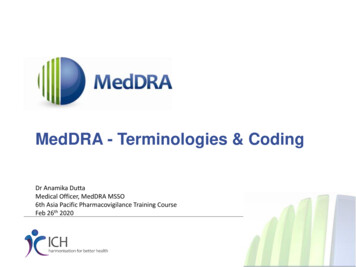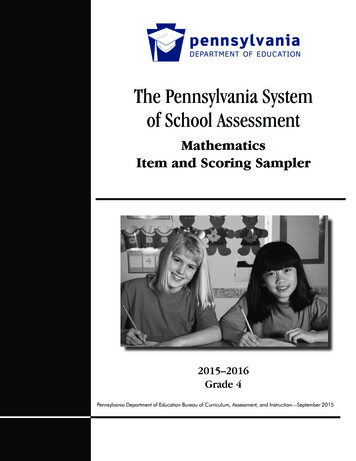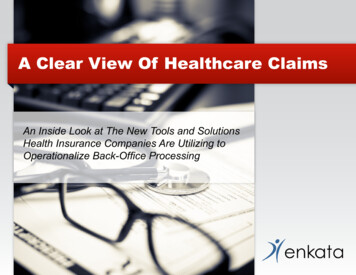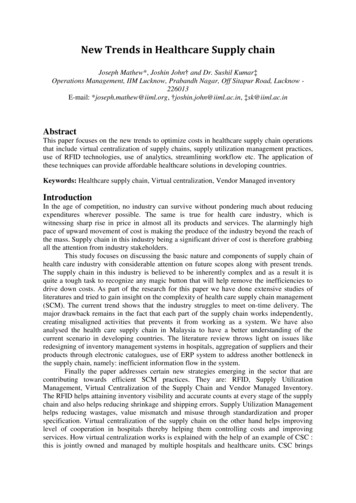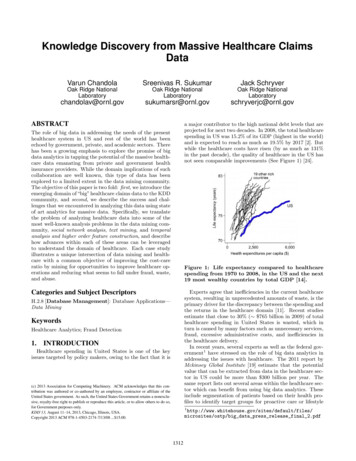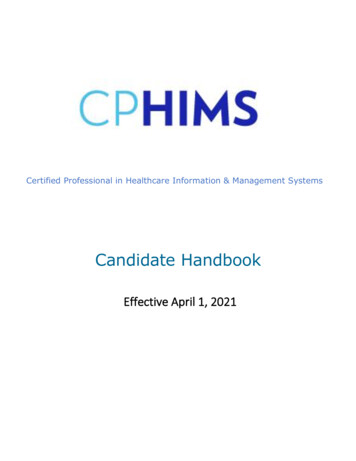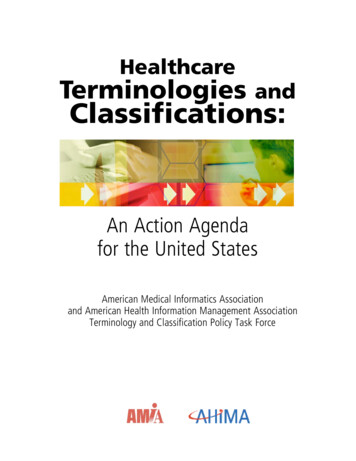
Transcription
HealthcareTerminologies andClassifications:An Action Agendafor the United StatesAmerican Medical Informatics Associationand American Health Information Management AssociationTerminology and Classification Policy Task Force
AcknowledgementsAHIMA and AMIA Terminology andClassification Policy Task Force MembersThe American HealthInformation ManagementAssociation (AHIMA) is thepremier association of healthinformation management(HIM) professionals. AHIMA’s51,000 members are dedicated tothe effective management ofpersonal health informationneeded to deliver qualityhealthcare to the public.Founded in 1928 to improve thequality of medical records,AHIMA is committed toadvancing the HIM profession inan increasingly electronic andglobal environment throughleadership in advocacy,education, certification, andlifelong learning. To learn more,go to www.ahima.org.Keith E. Campbell, MD, PhDChair, AHIMA and AMIA Terminologies and Classifications Policy Task ForceChief Technology Officer, Informatics, Inc., and Assistant Clinical Professor;Department of Medical Informatics and Clinical Epidemiology, Oregon Health andScience UniversitySuzanne Bakken, RN, DNSc, FAANAlumni Professor of Nursing and Professor of Biomedical Informatics School ofNursing and Department of Medical Informatics, Columbia UniversitySue Bowman, RHIA, CCSDirector of Coding Policy and Compliance, American Health InformationManagement AssociationChristopher Chute, MD, PhDProfessor and Chair of Biomedical Informatics, Mayo FoundationDon Detmer, MD, MAPresident and Chief Executive Officer, American Medical Informatics AssociationJennifer Hornung Garvin, PhD, RHIA, CPHQ, CCS, CTR, FAHIMAMedical Informatics Postdoctoral Fellow Center for Health Equity Research andPromotion, Philadelphia Veterans Administration Medical CenterKathy Giannangelo, MA, RHIA, CCS, CPHIMSDirector, Practice Leadership, AHIMAThe American MedicalInformatics Association (AMIA)is the premier organization inthe United States dedicated tothe development and applicationof medical informatics in thesupport of patient care, teaching,research, and healthcareadministration. AMIA linksdevelopers and users of healthinformation technology, creatingan environment which fostersadvances that revolutionizehealthcare. To learn more, go towww.amia.org.Gail Graham, RHIADirector, Health Data and Informatics Department of Veterans AffairsStanley M. Huff, MDProfessor of Medical Informatics, University of Utah Senior Medical Informaticist,Intermountain HealthcareLinda Kloss, MA, RHIA, FAHIMAChief Executive Officer, AHIMAMargaret Skurka, MS, RHIA, CCSProfessor and Director of Health Information Programs, Indiana University NorthwestMary Stanfill, RHIA, CCS, CCS-PVice President, Practice Resources, AHIMAValerie Watzlaf, PhD, RHIA, FAHIMAAssociate Professor, Department of Health Information Management, School ofHealth and Rehabilitation Sciences, University of Pittsburgh
Healthcare Terminologies and Classifications: An Action Agenda for the United StatesTable of ContentsExecutive Summary . . . . . . . . . . . . . . . . . . . . . . . . . . . . . . . . . . . . . . . . . . . . . . . . . . . . . . . . . . . . . . .4Background . . . . . . . . . . . . . . . . . . . . . . . . . . . . . . . . . . . . . . . . . . . . . . . . . . . . . . . . . . . . . . . . . . . . . .5Magnitude of the Problem . . . . . . . . . . . . . . . . . . . . . . . . . . . . . . . . . . . . . . . . . . . . . . . . . . . . . . . . .7The Vision and Goals for the US . . . . . . . . . . . . . . . . . . . . . . . . . . . . . . . . . . . . . . . . . . . . . . . . . . . .9What to Do Next . . . . . . . . . . . . . . . . . . . . . . . . . . . . . . . . . . . . . . . . . . . . . . . . . . . . . . . . . . . . . . . .15Role of AHIMA and AMIA . . . . . . . . . . . . . . . . . . . . . . . . . . . . . . . . . . . . . . . . . . . . . . . . . . . . . . . .18Conclusion . . . . . . . . . . . . . . . . . . . . . . . . . . . . . . . . . . . . . . . . . . . . . . . . . . . . . . . . . . . . . . . . . . . . .19Table 1: Governance of Various Terminology Systems . . . . . . . . . . . . . . . . . . . . . . . . . . . . . . . . . .20Table 2: Development and Maintenance of Various Terminology Systems . . . . . . . . . . . . . . . . .23Appendix A: Australia, the United Kingdom, and Canada . . . . . . . . . . . . . . . . . . . . . . . . . . . . . .27Appendix B: Terminology Services and Tools . . . . . . . . . . . . . . . . . . . . . . . . . . . . . . . . . . . . . . . . .29Table 3: Terminology Services and Tools in Four Organizations . . . . . . . . . . . . . . . . . . . . . . . . .30Glossary . . . . . . . . . . . . . . . . . . . . . . . . . . . . . . . . . . . . . . . . . . . . . . . . . . . . . . . . . . . . . . . . . . . . . . .323This white paper is a revised version of a paper originally released by AHIMA and AMIA in 2006. 2007
Healthcare Terminologies and Classifications: An Action Agenda for the United StatesExecutive SummaryTerminologies and classifications form thefoundations of information content in theelectronic health record (EHR) and are thebasis for research, public health reporting, andhealthcare payment.1 They are integral tointeroperability and, thus, a successful nationalhealth information system that promisesincreased patient safety and reduced costs.Although there has been significant progress inthe United States to better understand the roleterminologies play in our health informationsystems, and to make terminologies morebroadly available in machinable forms, moremust be done to ensure that this progressserves as a robust foundation for theinformation content of the EHR.4The healthcare industry–including thegovernment, professional organizations, publicand private institutions, and health informaticsand information management professionals–must address the issues before the UShealthcare system is marginalized. To not do sowould mean continued reliance on poorquality data for decision making and thespending of dollars to retrofit a system that isobviously broken.This report describes challenges that requireaction. It proposes the formation of acentralized terminology authority, and othersteps, to address these challenges.Task Force Vision andRecommendationsThe American Medical Informatics Association(AMIA) and the American Health InformationManagement Association (AHIMA) are pleasedwith the progress made thus far and arecommitted to the development of the emergingnational health information system. But bothorganizations recognize that additionalresources and appropriate funding are neededto build on initial work for healthcareterminologies and classifications strategy,governance, and development andmaintenance processes.To address these issues, AHIMA and AMIAconvened a Terminology and ClassificationPolicy Task Force composed of experts inmedical and nursing informatics (a field thatstudies the support of medicine by informationsystems), health information managementprofessionals, experts in nosology (the branchof medicine that deals with the classification ofdiseases), and educators. The group’s goal wasto develop recommendations for the majorchallenges that would help establish a processthat results in interoperability. The Task Forcehas formulated a vision and associated goalsand recommendations that it hopes will beused to frame a public-private dialogue abouthow to redesign the US approach to healthcareterminologies and classifications against abackdrop of international approaches andachievements.The vision consists of the following: US governance occurs from a nationalperspective against a backdrop ofinternational agendas. US policy coordinates with othercountries, and the US actively collaboratesand shares costs. Coordination and collaboration occurswith international terminology andclassification development andmaintenance initiatives.1. For purposes of this report, an EHR is defined as an information system designed to provide access to complete andaccurate clinical data, practitioner alerts and reminders, clinical decision support systems, and links to medical knowledge.Giannangelo, K. (Ed). Healthcare Code Sets, Clinical Terminologies, and Classification Systems. AHIMA. [Note: Within thisdefinition, a personal health record (PHR) only qualifies as an EHR if it is part of an EHR having the identified capabilities.]
Healthcare Terminologies and Classifications: An Action Agenda for the United States Terminologies, classifications, and mapsform a coherent set of policies andprocedures for openness and ensuredperformance. Transparency of process exists even whenthe development organization maintainsthe system within its own organization. Infrastructure for development andmaintenance of the terminology is subjectto an open process. Business process automation isimplemented, allowing organizations toparticipate and track the terminology andclassification development processes,reducing cost, and automating manyaspects of the system release cycles.To implement this vision, the Task Forcerecommends that the healthcare industry—government, public and private institutions,and professional organizations—collaboratively undertake the following tasks: Create a publicly funded research anddevelopment project to preparespecifications for coordinated solutionsand where possible, consolidateterminology. Secure funding for the planning anddevelopment of a centralized authority,representing both public and privatestakeholders, to manage the funding andbe responsible for overseeing USterminology and classificationdevelopment and maintenance, includingthe supporting systems. Develop a governance model for thecentral authority that is accountable to theneeds of the end users and implementers,and also has accountability for the fundingof the central authority. Commit to the adoption of soundprinciples for operation of a terminologyand classification standards developmentorganization.The Task Force believes that the items on thisagenda must be accomplished. To this end,AHIMA and AMIA are ready to lead, inconcert with the appropriate governmentagencies, the US effort for terminologies andclassification reform. They recognize the USagenda for health information reform willrequire strong public and private collaboration.In the months to come, AHIMA and AMIAwill convene stakeholders to build a broaderunderstanding of the current problems,generate wide support for, and begin toconstruct a road map for change.5
Healthcare Terminologies and Classifications: An Action Agenda for the United StatesHealthcare Terminologies and Classifications:An Action Agenda for the United StatesBackgroundHealthcare classifications (systems that arrangetogether similar diseases and procedures andorganizes related entities for easy retrieval) andclinical terminologies (standardized terms andtheir synonyms that record patient findings,circumstances, events, and interventions) arethe systems that describe, organize, andstandardize the rapidly evolving language ofmedicine. In addition, terminologies andclassifications form the information content inthe electronic health record (EHR) and thepersonal health record. They are the basis forpublic health reporting, performancemeasurement and quality reporting, research,and billing and payment for healthcareservices. They are integral to interoperability,and thus, to deployment of a nationwide healthinformation network (NHIN) capable ofdelivering on the promise of safer and morecost-effective results.6An NHIN and the interoperable exchange ofhealth information between standard EHRs ofhealthcare data depend on: Clinical content identified with clinicalterminologies, which maintain highlyspecific and descriptive patient care dataand classifications for aggregate reportingthat can be reliably captured, encoded,exchanged, and interpreted Common information models Management and coordination of thevarious terminology and classificationsystems in a synchronized fashion for astreamlined life cycleHow Terminologies and ClassificationSystems Are UsedClinical terminologies and classificationsystems have been in use for many years—forexample, the International Classification ofDisease (ICD) was created in the 19th centuryas a way to identify the causes of death. TheSystematized Nomenclature of Medicine(SNOMED) began as an enhancement to theStandard Nomenclature of Diseases andOperations, first published in 1965 and usedto organize information from surgicalpathology reports.In addition to their lengthy history, terminologiesand classifications can be used in different ways .For example, terminologies are used pri m a ri ly toc a pture clinical information. As such, they arehighly detailed and have substantial granularity,but at the same time they lack reporting rulesand guidelines.Classification systems are intended forsecondary data use, including quality of caremeasurement, reimbursement, statistical andpublic health reporting, operational andstrategic planning, and other administrativefunctions. While reporting rules and guidelinesfor administrative code sets exist, not everyoneis following them.In the United States, the most commonly usedsystems are the International Classification ofDiseases, Ninth Revision, Clinical Modification(ICD-9-CM) and the Current ProceduralTerminology (CPT ). These systems are usedto organize specific diseases and procedures ina general classification schema. This allows thespecific diseases and procedures to be groupedinto more broad-based categories and thenused for reimbursement (ICD-9-CM codes to
Healthcare Terminologies and Classifications: An Action Agenda for the United StatesDiagnosis-Related Groups), quality of caremeasures (ICD-9-CM codes to patientsatisfaction rankings), or resource utilizationmeasures (CPT codes to cost of care). Becauseclassification systems are considered broaderways to classify specific diseases andprocedures, they are not the most appropriatesystem to use to identify and capture theclinical aspects of an episode of care.For example, in ICD-9-CM and its 10threvision, ICD-10-CM, a hospital stay for anewborn is represented by codes identifyingthe type of birth (that is, live-born infant,single or multiple births, born in hospital oroutside of hospital, and vaginal versus cesareandelivery) and medical conditions or risk factorsthe infant may have. In contrast, SNOMEDCT codes provide the complete clinical detailfor a healthcare encounter. The Apgar score(an assessment of the physical condition of anewborn infant), for example, would berepresented by separate SNOMED CT codesfor the cardiac score, respiratory score, muscletone, reflex response, and color.2Together, terminologies, such as SNOMEDCT , and classification systems, such as ICD-9CM, ICD-10-CM, and ICD-10-PCS, providethe common medical language necessary forthe EHR and for population health reporting,quality reporting, personal health records,safety, clinical trials, biosurveillance, andreimbursement.Terminologies, Classifications, andInformation ModelsBut simply having a list of relevant words isnot the same as representing all the relevantdata in a computable form. The process of dataor information representation begins withinformation models, not just the terms andcodes alone. For clinical data representation, alibrary of shared models linked to value setsdrawn from standard coded terminologies andclassifications is needed. This means resolvingissues related to the interface betweeninformation models.Both the National Committee on Vital andHealth Statistics (NCVHS) and the Institute ofMedicine have noted that standardrepresentation of the full meaning of patientmedical data requires integrating terminologymodels with models of context and otherstructural relationships.3, 4 The NCVHS has alsoconcluded when patient medical recordinformation standards do not include acomprehensive information model andterminology model, mapping is made moredifficult.Terminologies, Classifications, andMappingMapping is a process that links the contentfrom one terminology or classification schemeto another.5Many factors within the healthcare industry aredriving mapping technology, including themovement to adopt EHRs and create a NHIN.6Efforts to control increased administrativecosts within healthcare are also a factor. Theshortage of qualified coders increases costs andinefficiencies. These issues exacerbate the needfor computer-assisted coding (the automaticgeneration of codes based on clinicaldocumentation) and the use of mappingtechnologies to increase productivity andcoding consistency. Today, computer-assistedcoding and mapping systems are an achievablevision for the future, but there is still some wayto go.2. Dougherty, M. “Standard Terminology Helps Advance EHR.” Journal of AHIMA 74, no. 10 (2003): 59-60.3. National Committee on Vital and Health Statistics. Patient medical record information terminology analysis reports. 2002.4. Institute of Medicine. “Key Capabilities of an Electronic Health Record System.” Letter Report of theCommittee on Data Standards for Patient Safety, Board on Health Care Services, Institute of Medicine, 2003.5. Available at www.nlm.nih.gov/healthit.html.6. Available at www.nlm.nih.gov/healthit.html.7
Healthcare Terminologies and Classifications: An Action Agenda for the United StatesAn EHR that can map from a referenceterminology to a classification system is rare.There are currently no nationally orinternationally recognized standards for mapdevelopment and validation. In addition, thereis a lack of coordination among terminologyand classification development organizations,which inhibits the development of maps. Thereis also no standard definition of a “valid” map.Iterative research and development is needed,along with testing in real environments, toachieve a usable map.The NLM has taken a lead in this importantarea and has made maps from SNOMED CT to ICD-9-CM, SNOMED CT to CPT, and aLOINC to CPT preliminary draft available.These maps can serve as a starting point for thedevelopment of standards and for testing theutility of different mapping approaches.Magnitude of the Problem8The terminologies and classifications lifecycle—in particular, development, distribution,and maintenance—is complex. Thiscomplexity causes problems for all who deal insome form or another with them. There are arelatively small number of vendors, andexisting systems are not able to seamlesslyexchange information with other systems. Thismakes commercial offerings challenging andcreates a high risk of vendor lock in7 andsignificant susceptibility to vendor failure. Inaddition, no comprehensive open sourcedevelopment environment exists, resulting inauthoring environments that are notsufficiently responsive to improve the creationand revision of terminologies. The outcome isthe creation of content in the system based ona defined need rather than desirablecharacteristics of a controlled clinicalterminology.8 Current terminology effortstypically do not meet rudimentarydevelopment practices considered routine forsoftware development in other industries orsubject domains. Terminology systems alsoprobably do not meet Food and DrugAdministration standards9 for embeddedsoftware—yet many should.The situation is complicated by the lack ofbusiness process automation10 acrossorganizations or departments for updating ormaintaining the terminology. Even a singleorganization is required to use multiple tools ifit is to function today. Appendix A illustratesthis complexity for four healthcareorganizations.Adoption and implementation are inthemselves complicated issues, with manygoverning bodies determining what systemshould be adopted and implemented. Inaddition, while there have been discussionsabout the basic principles for maintenance andwhat the ideal process should look like,attributes and standards for terminologydevelopment and maintenance processes havenot been brought forth, discussed, or agreed toby the principal stakeholders—that is, theowners of the terminologies and classificationsand the users of the systems. Simply findingout what systems already exist, what they are7. Wikipedia states vendor lock-in is a situation in which a customer is so dependent on a vendor for products and servicesthat he or she cannot move to another vendor without substantial switching costs, real and/or perceived.8. Cimino, J. “Desiderata for Controlled Medical Vocabularies in the Twenty-First Century.” Methods of Information inMedicine 37 (1998): 394-403.9. Many of the regulations enforced by the Food and Drug Administration (FDA) with regard to medical devices can befound in Title 21 Code of Federal Regulations (CFR) Part 800 to Part 1299. The information required in a 510(k)submission is defined 21 CFR 807.92. Among the list of 510(k) submission requirements is software development,verification and validation information.10. Wikipedia states business process automation is the process of integrating enterprise applications, reducing humanintervention wherever possible, and assembling software services into end-to-end process flows.
Healthcare Terminologies and Classifications: An Action Agenda for the United Statesused for, when they were adopted andimplemented, who maintains them, and whatthe release cycles are can be an onerous task.The Vision and Goals forthe USToday’s proprietary standard developmentmodels hamper development and maintenanceof terminology standards by prohibiting openpublication of content. Terminology systemsare significantly lacking in any principledapproach to validation and quality assurance.The American Medical Informatics Association(AMIA) and the American Health InformationManagement Association (AHIMA) are pleasedwith the progress made thus far and arecommitted to the development of the emergingnational health information system. But bothorganizations recognize that additionalresources and appropriate funding are neededto build on initial work for healthcareterminologies and classifications strategy,governance, and development andmaintenance processes.Despite its essential need, insufficient fundinghas also plagued the development andmaintenance of clinical terminologies andclassifications for years. The bulk of the work isdone by volunteers—experts in medical andhealth informatics, health informationmanagers, and experts in nosology (the branchof medicine that deals with the classification ofdiseases).Other widely acknowledged problems include: The lack of sufficient incentives tocooperate Systems are seen as independent when theyare highly interdependent A general lack of understanding of howencoded data can support initiatives suchas quality or patient safety in thehealthcare environmentTo address these issues, AHIMA and AMIAconvened a Terminology and ClassificationPolicy Task Force composed of experts inmedical and nursing informatics (a field thatstudies the support of medicine by informationsystems), health information managementprofessionals, experts in nosology, andeducators. The group’s goal was to developrecommendations for the major challenges thatwould help establish a process that results ininteroperability. The Task Force has formulateda vision and associated goals andrecommendations that it hopes will be used toframe a public-private dialogue about how toredesign the US approach to healthcareterminologies and classifications against abackdrop of international approaches andachievements.The Vision: The Task Force’s vision of theideal state for terminologies and classificationstakes into account key issues includinggovernance, licensing, and the methods used inthe terminologies and classifications lifecycle—specifically, development, distribution,and maintenance. It consists of the following: US governance occurs from a nationalperspective against a backdrop ofinternational agendas.9
Healthcare Terminologies and Classifications: An Action Agenda for the United States10 US policy coordinates with othercountries, and the US should activelycollaborate and share costs. Coordination and collaboration occurswith international terminology andclassification development andmaintenance initiatives. Terminologies, classifications, and mapsform a coherent set of policies andprocedures for openness and assuredperformance. There is transparency of process even if thedevelopment organization maintains thesystem within its own organization. The infrastructure for development andmaintenance of the terminology is subjectto an open process. The characteristics ofthis process include:-Any classification algorithms requiredto transform terminology stated formsinto inferred forms are publiclydescribed and free of patent royaltiesso that any party may implement aterminology-capable classifierunencumbered.-Interfaces to the terminologydevelopment infrastructure(automated term submission process,automated update services,terminology configurationmanagement services, andterminology authoring services) arepublicly described and licensed underan open source agreement such as theApache 2 license.11 An open sourcelicense is meant to ensure that anyparty can freely develop software thatcan interact with or replacecomponents of the terminologydevelopment infrastructureunencumbered by licensure fees,patent royalties, or from otherlicensing restrictions that may requirecommercial organizations to disclosetheir proprietary source code. Alicense that requires a vendor to opentheir source code, such as the GNU(free software) style licenses, isinappropriate.- Any fees associated with mandatedinfrastructure necessary to implementthe standard are under regulatorycontrol to assure that fees to supportthe infrastructure are not diverted.Business process automation that allowsorganizations to participate and track theterminology development process,reducing cost and automating manyaspects of the terminology release cycle isput in place.The Goals: The goals of a coordinated policyfor the US that enables the TaskForce vision builds upon lessons fromnational and international efforts in threeareas: (1) governance, (2) development andmaintenance, and (3) acquisition, licensing,and implementation issues.GovernanceThe Task Force recommended theestablishment of a centralized oversightauthority to accomplish these governancegoals: Ensure consistency in processes, systemcoordination, responsiveness to end users(vendors and those who use their systems),and the availability of robust, valid maps. Adopti on of u n i form rules, regulations, andg u i delines for standard i zed term i n o l ogyand up-to-date classification sys tems ac rossthe co u n try.11. Available at http://www.apache.org/licenses/LICENSE-2.0.html.
Healthcare Terminologies and Classifications: An Action Agenda for the United States Ensure that the organizations authorized todevelop, deploy, and maintain suchstandards and guidelines assume ongoingresponsibility to provide clarity with aspecific standard or guideline as required,publish and disseminate the standards orguidelines in a manner that is generallyunderstood, and respond in a timelymanner to all requests for clarification ofstandards or guidelines.Simplifying GovernanceMeeting this goal will require changes in theway in which the US governs terminologiesand classifications. In the US, there is nocentralized oversight of terminologies andclassifications. Terminologies andclassifications have their own governanceprocess dictated by the organization who“owns” the system. Table 1 provides a summaryof the owners and governance processes forvarious terminology systems currently used inthe US. In many cases, the governance processis strictly an internal function of theterminology development organization withlittle detail available publicly. In a few cases, thegovernance process includes oversight by acommittee composed of users and otherstakeholders. The fragmentation illustrated inTable 1 prohibits interoperability. The numberof systems in existence and the resultingacronym alphabet soup make apparent theexisting complexity of governance.An important consideration when choosing tointegrate a component such as a terminology isto understand the governance model of theorganization providing the component, eithervia license or through contribution to thepublic domain. For example, the problem withthird-party control is particularly challengingfor SNOMED CT because the governance ofSNOMED CT development and licensingpolicies has been subject to approval by theCAP board of governors, not by the end usersor licensees of the SNOMED CT terminologystandard. In contrast, HL7’s board of directorsis elected by the HL7 members and is fiduciallybound to serve their interests. The proposedformation of a new SNOMED SDO outside ofCAP most likely will resolve this importantgovernance issue.Fragmentation of the governance process isalso illustrated by the current situation withthe ICD. While the National Center for HealthStatistics (NCHS) maintains the US clinicalmodification if ICD-9-CM and ICD-10-CMfor diagnosis coding, the Centers for Medicareand Medicaid Services (CMS) are responsiblefor development and maintenance of theprocedure coding systems. While subject to asingle coordination and maintenancecommittee, coordination of these two essentialdimensions could and should be strengthened.Recognizing that the US could learn much fromother co u n tries that have already rede s i gn edtheir govern a n ce and su pport processes forterminologies andcl a s s i f i c a ti on s , the Task Forcestu d i ed the approaches taken by Ca n ada,Australia, and the Un i ted Ki n gdom. Details foreach co u n try are found in Appendix B.Development and MaintenanceThe Task Force identified the following goalsfor terminologies and classificationsdevelopment and maintenance: The infrastructure for development andmaintenance of the terminology is subjectto an open process. The characteristics ofthis process include:-Any classification algorithms requiredto transform terminology stated f
Health and Rehabilitation Sciences, University of Pittsburgh The American Health Information Management Association (AHIMA) is the premier association of health information management (HIM) professionals. AHIMA’s 51,000 members are dedicated to the effective management of personal health in



